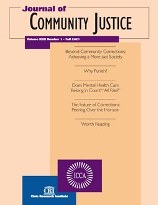Complete Issue
Author: Donald G. Evans.
Source: Volume 22, Number 04, Summer 2013 , pp.1-28(28)

< previous article |return to table of contents
Abstract:
In this issue of JCC, we have assembled some thoughtful articles that should assist readers in their practical work with offenders. The articles look at the importance of understanding the prison experience for community supervision, the characteristics of female sex offenders, and a program to improve employment opportunities for offenders. Katharina Maier and Dr. Rose Ricciardelli examine offender’s perceptions and experiences of threat and safety in prison. Specifically, the authors analyze how male prisoners experience penal threats and create safety during their incarceration, and the implications of these understandings and behaviors for their prison experience and post-release responses. Prisoners’ efforts at self-preservation are influenced by perceived threats and the need to navigate multiple risks. This exploration of aspects of the “pains of imprisonment” is informative and raises questions for future research; it also encourages case managers in the community to be cognizant of the prison experiexperience when working with released offenders. Dr. Lisa Degiorgio and Dr. Herman Lindeman use the Sexual Adjustment Inventory to compare psychosocial differences between male and female sex offenders. The study used a subset of 206 females charged with or convicted of a sexual offense for this comparison. From this sample, female sex offenders who demonstrated severe problems were then compared to all other female respondents. The results help enhance the emerging profile of female sex offenders, have value for clinical practice, including risk and need identification, and assist in matching offenders to appropriate treatment modalities. A conversation with Graham Lewis, employment specialist with St. Leonard’s Society of Toronto, explores his work in finding employment for offenders being supervised by the Society’s Crossroads Day Reporting Centre. The interview covers challenges faced by offenders in finding employment, the value of engaging employers about the specific needs of offenders, and the ways in which myths about offenders are broken down so as to encourage employers to hire offenders. Issues such as information sharing with employers and managing expectations are also covered in this interview. Lewis also explains his views about why employment is an important aspect of offender reintegration and outlines some of the lessons that have been learned in the Crossroads employment program. I am hoping that this is the first of other conversations with practitioners about what they do and how they go about delivering appropriate services that meet the needs of offenders and assist in keeping communities safe. Our book review editor, Russ Immarigeon, has assembled an interesting collection of reviews of recent additions to the literature on punishment, rehabilitation, and corrections. There are two reviews of books dealing with women offenders, two dealing with Nordic approaches to crime and justice, and a useful look at 50 years of community mental health efforts. I was particularly interested in the new SAGE Handbook of Punishment and Society. The contributors to this Handbook are academics, but the work allows for practitioners to view their practice in a larger context and provides for critical thought and reaction to the issues discussed.Keywords: Prison security, safety, and fear of harm; female sex offenders; offender employment
Affiliations:
1: Journal of Community Corrections Editor.